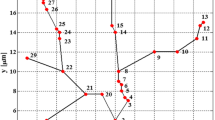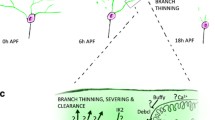Abstract
The nonlinear dynamic analysis of time series is a powerful tool which has extended its application to many branches of scientific research. Topological equivalence is one of the main concepts that sustain theoretically the nonlinear dynamics procedures that have been implemented to characterize the discrete time series. Based on this concept, in this work a novel way to analyze dendritic trees with high complexity is reported, using features obtained through splitting the 3D structure of the dendritic trees of traced neurons into time series. Digitally reconstructed neurons were separated into control and pathological sets, which are related to two categories of alterations caused by the reduced activity of the adult born neurons (ABNs) in the mouse olfactory bulb. In the first category, a viral vector encoding a small interfering RNA (siRNA) to knock-down sodium channel expression and a second category a naris occlusion (NO) method is applied to reduce the activity of ABNs that migrate to the olfactory bulb. Using the method proposed in this study the mean result of the correct classification was improved in 4.8 and 2.76% for the NO and siRNA sets respectively, while the maximum correct classification rates were improved in 9.53 and 2.5% respectively, when compared to methods based in the use of morphological features.
Access this chapter
Tax calculation will be finalised at checkout
Purchases are for personal use only
Similar content being viewed by others
References
Armañanzas, R., Ascoli, G.A.: Towards automatic classification of neurons. Trends Neurosci. 38, 307–318 (2015). https://doi.org/10.1016/j.tins.2015.02.004
Sholl, D.A.: Dendritic organization in the neurons of the visual and motor cortices of the cat. J. Anat. 87, 387–406 (1953)
Bianchi, S., Stimpson, C.D., Bauernfeind, A.L., Schapiro, S.J., Baze, W.B., McArthur, M.J., et al.: Dendritic morphology of pyramidal neurons in the chimpanzee neocortex: regional specializations and comparison to humans. Cereb. Cortex 23(10), 2429–2436 (2013). https://doi.org/10.1093/cercor/bhs239
Di Ieva, A., Grizzi, F., Jelinek, H., Pellionisz, A.J., Losa, G.A.: Fractals in the neurosciences, part I: general principles and basic neurosciences. Neurosci. Rev. J. Bringing Neurobiol. Neurol. Psychiatry 20, 403–417 (2013). https://doi.org/10.1177/1073858413513927
Di Ieva, A., Esteban, F.J., Grizzi, F., Klonowski, W., Martín-Landrove, M.: Fractals in the neurosciences, part II: clinical applications and future perspectives. Neurosci. Rev. J. Bring. Neurobiol. Neurol Psychiatry 21, 30–43 (2015). https://doi.org/10.1177/1073858413513928
Rand, D., Young, L.-S. (eds.): Dynamical Systems and Turbulence, Warwick 1980. LNM, vol. 898. Springer, Heidelberg (1981). https://doi.org/10.1007/BFb0091903
NeuroMorpho_Linkout. http://neuromorpho.org/NeuroMorpho_Linkout.jsp?PMID=12902394
Hernández-Pérez, L.A., Delgado-Castillo, D., Martín-Pérez, R., Orozco-Morales, R., Lorenzo-Ginori, J.V.: New features for neuron classification. Neuroinformatics 1–21 (2018). https://doi.org/10.1007/s12021-018-9374-0
Scorcioni, R., Polavaram, S., Ascoli, G.A.: L-Measure: a web-accessible tool for the analysis, comparison and search of digital reconstructions of neuronal morphologies. Nat. Protoc. 3, 866–876 (2008). https://doi.org/10.1038/nprot.2008.51
Rosenstein, M.T., Collins, J.J., Luca, C.J.D.: A practical method for calculating largest Lyapunov exponents from small data sets. Phys. D 65, 117–134 (1993)
Sprott, J.C.: Chaos and Time-Series Analysis. Oxford University Press, Oxford (2003)
Hamilton, P., West, B.: Software review chaos data analyzer, professional version. Nonlinear Dyn. Psychol. Life Sci. 4, 195–199 (2000). https://doi.org/10.1023/A:1009580513427
Kugiumtzis, D., Tsimpiris, A.: Measures of analysis of time series (MATS): a MATLAB toolkit for computation of multiple measures on time series data bases. ArXiv10021940 Stat. (2010)
Scorcioni, R., Lazarewicz, M.T., Ascoli, G.A.: Quantitative morphometry of hippocampal pyramidal cells: differences between anatomical classes and reconstructing laboratories. J. Comp. Neurol. 473, 177–193 (2004). https://doi.org/10.1002/cne.20067
Foster, K.R., Koprowski, R., Skufca, J.D.: Machine learning, medical diagnosis, and biomedical engineering research—commentary. Biomed. Eng. OnLine 13, 94 (2014). https://doi.org/10.1186/1475-925X-13-94
Bouckaert, R., et al.:: WEKA Manual for Version 3-6-13. CreateSpace Independent Publishing Platform (2015)
Dahlen, J.E., Jimenez, D.A., Gerkin, R.C., Urban, N.N.: Morphological analysis of activity-reduced adult-born neurons in the mouse olfactory bulb. Front. Neurosci. 5 (2011). https://doi.org/10.3389/fnins.2011.00066
Author information
Authors and Affiliations
Corresponding author
Editor information
Editors and Affiliations
Rights and permissions
Copyright information
© 2018 Springer Nature Switzerland AG
About this paper
Cite this paper
Hernández-Pérez, L.A., López-Cabrera, J.D., Orozco-Morales, R., Lorenzo-Ginori, J.V. (2018). Classification of Neuron Sets from Non-disease States Using Time Series Obtained Through Nonlinear Analysis of the 3D Dendritic Structures. In: Hernández Heredia, Y., Milián Núñez, V., Ruiz Shulcloper, J. (eds) Progress in Artificial Intelligence and Pattern Recognition. IWAIPR 2018. Lecture Notes in Computer Science(), vol 11047. Springer, Cham. https://doi.org/10.1007/978-3-030-01132-1_2
Download citation
DOI: https://doi.org/10.1007/978-3-030-01132-1_2
Published:
Publisher Name: Springer, Cham
Print ISBN: 978-3-030-01131-4
Online ISBN: 978-3-030-01132-1
eBook Packages: Computer ScienceComputer Science (R0)




